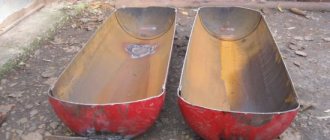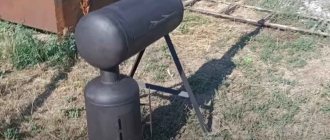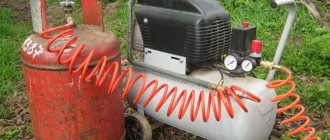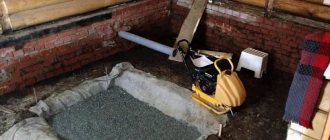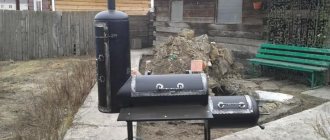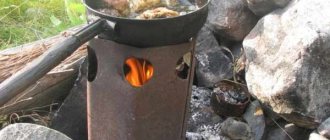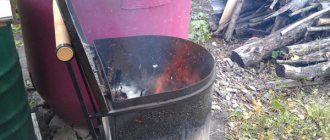A potbelly stove is a simple heating device with more than a century of history. And if at the dawn of its appearance it was made from scraps of pipes and metal barrels, today a stove made from a gas cylinder is becoming an increasingly popular option for heating garages and baths. We figure out how to choose a cylinder for work, what kind of stove can be made from it, and in what order the work is performed.
Potbelly stove - a compact and efficient heating device Source ytimg.com
Methods of use and varieties
In our native land, a homemade stove made from a gas cylinder is a common source of heat in the winter. Most units are designed quite simply. According to the principle of operation, they are similar to a metal wood-burning stove: heat is released into the surrounding space through a body that is heated due to the combustion of wood (or other fuel). Homemade designs are used in the following situations:
- In the summer at the dacha for cooking food for people and animals.
- In winter for heating a garage, workshop, utility rooms.
- In residential areas for cooking and heating (enough for one or two small rooms).
- For heating the bath.
- A backup option in case of emergency failure of the main heating system.
Stoves converted from a gas cylinder do not have a single standard, but nevertheless, they can be classified according to the following parameters:
- According to the location of the cylinder. There are vertical and horizontal stoves; There are combined and double options. A vertical stove can often be found in a garage or utility room; horizontal ones are used for cooking and heating baths and living quarters.
Potbelly stove with hob Source termopaneli59.ru
- By design. A standard stove has a rather low efficiency; a significant part of the energy literally flies down the drain. There is an improved option: pyrolysis furnaces, which include the bubafonya furnace and the rocket furnace. They are designed to maintain long-lasting combustion.
- By choice of fuel. Mostly, potbelly stoves run on natural fuel - wood, but there are models that use coal, waste (diesel), peat, and pellets (pressed sawdust).
Pros and cons of the design
Every car enthusiast knows how uncomfortable it is in a garage without heating during the cold season. But excellent thermal conductivity and quick heat generation are not the only benefits of using a potbelly stove from a gas cylinder. Owners of garages, cottages and bathhouses are aware of other advantages of the heating device:
- Saving. Manufacturing requires standard, inexpensive parts. You get a unit at minimal cost, which is pleasantly different from the price tag of a finished metal stove. Available fuel is used for combustion.
Furnace in operation, operating mode Source ytimg.com
- Ease of manufacture. The work can be done on your own, without the involvement of specialists. There are a lot of videos collected online that can help you learn the technology for assembling a potbelly stove of any design.
- Convenient dimensions. You can make a device to fit the size of a bathhouse or garage.
- Easy operation and maintenance. The cylinder produces a stove suitable for heating baths, residential and utility rooms.
It is important to know about the following disadvantages of the device:
- To work, you need to choose reliable, proven drawings; The efficiency of a random unit may be low.
- Due to its design and material, the structure does not retain heat: as soon as the fire goes out, it immediately cools down.
- It is strictly forbidden to heat a potbelly stove with waste (used lubricants) in a residential area. This is not only harmful to health, but also a potential explosion and fire hazard. The place for installing any stove is finished with fire-resistant materials.
Diagram and dimensions of a country potbelly stove Source technicalservice59.rf
Stoves operating on exhaust have a separate drawback: due to the specifics of the fuel, more soot is formed, and the chimney has to be cleaned more often. In any case, when using liquid fuel, good air circulation is necessary, and this is possible with an established ventilation system.
Modern heating boilers using wood
Traditional solid fuel boilers running on wood are considered the most famous among similar devices. They have a conventional design of a large volume combustion chamber and a cast iron heat exchanger.
Their main advantages are a simple thermal cycle of operation and energy independence. You can also connect a gas boiler to a propane cylinder if the additional fuel is liquefied gas, and the solid fuel boiler will include a special burner for gas or even oil when you need to process fuel and lubricant waste.
However, they also have a significant drawback: a short period of operation with one load of fuel is no more than 3-4 hours, in addition, they are never wall-mounted.
Pyrolysis solid fuel heating units are designed to operate on mostly hard wood. Such heating sources are equipped with two combustion chambers; in the first, primary combustion occurs with a deficiency of oxygen, which triggers the pyrolysis process with gas generation. In the second, the pyrolysis gas burns out, which increases the efficiency of the boiler to 90% and the operating time on one charge to 8 hours.
Long-burning wood-burning boilers are designed to work on any lumber; the operating time with one load of fuel is from 12 hours to several days.
A similar effect is achieved due to a special combustion chamber in which the process of upper combustion is organized, as a result of which the firewood slowly smolders. The large combustion volume, capable of loading about 50 kg of firewood, extends the operating time.
Selection and preparation of the cylinder
The first thing you need to decide is the size of the metal container. The size is chosen based on the area of the room in which the cylinder stove is supposed to be installed. You can choose from the following options:
- 5 l cylinder. A five-liter container can heat a small room. Little fuel fits into it, and only in the form of chips or briquettes.
- For 12 l. The furnace will be able to provide small (up to 3 kW) thermal power. The heat is enough to warm a small workshop, utility room or gatehouse.
- For 27-30 l. You will receive up to 7 kW, which will be enough to heat a garage, garden house or greenhouse.
- For 40 l. Industrial cylinders have a small diameter and thick walls, therefore, the fuel load will be small. It is better to shorten such a container and make a small stove that will hold heat longer and last longer.
Potbelly stove with heater for a bath Source s-proms.ru
See also: Catalog of companies that specialize in the design and installation of fireplaces and stoves
- For 50 l. A propane cylinder is considered the best option for making a potbelly stove; Such dimensions are capable of providing heat to the cottage.
The cylinder needs preparation: removal of gas residues. If cleaning is neglected, an explosion may occur when cutting metal. The cylinder will become safe after the following measures:
- Unscrew the valve to get rid of any remaining gas. You need to set aside a day, so the container is left to vent the gas in the open air or in a non-residential area with good ventilation.
- Then the container is turned over to drain the condensate (any unnecessary container with a lid will do - condensation has a pungent odor).
- At the end, the container is filled with water to the very top for several hours to displace residual vapors. After draining the water, the cylinder can be cut without danger.
Fuel requirements
Wood fuel for solid fuel boilers is grouped by type: homogeneous and mixed. The admixture of other types of wood in the first category should not exceed 5% of the total cubic capacity of the batch. Firewood is further divided by humidity: dry up to 25%, semi-dry from 25 to 34% and wet over 35%.
Firewood that has been stored in a warehouse for more than 12 months after harvesting is considered dry. Semi-dry timber is spring-harvested timber with a shelf life of at least 6 months.
For solid fuel boilers to operate, it is necessary that the firewood be of a dry category, this is due to the fact that in pyrolysis and long-burning devices operating at low combustion temperatures, wet firewood intensively releases moisture, which accumulates in the lower part of the firebox, combining with sulfur and nitrogen oxides .
Thus, it turns into acid, which corrodes the walls of the combustion chamber and welding seams. Through cracks in the latter, carbon monoxide and aggressive acid can enter the room.
What materials and tools are needed
To make a garage or sauna stove from a gas cylinder, choose a steel, seamless propane (household) cylinder with the following dimensions:
- Case length: 1660-1755 mm. Diameter: 219 mm.
- Wall thickness: 5.2-8.9 mm.
The gas must be removed from the container Source f12.pmo.ee
Dimensions may vary, but maximum deviations (especially in thickness) must comply with GOST 949-73 standards. The tools you need to prepare are:
- Welding machine (200 A). Protective equipment (welding mask with light filter, gloves). Electrodes for welding structural steels (diameter 3-4 mm).
- Grinding machine (grinder). It requires cutting and cleaning discs for metal (diameter from 180 mm).
- Workbench with a vice.
- Drill and set of drills.
- To clean up welding slag: metal brush (with metal bristles), sandpaper.
- Tools: pliers, chisel, hammer.
- For marking: tape measure or folding meter, chalk (marker).
The range of materials depends on the size, shape and purpose of the structure. The middle list includes the following items:
- Pipe for chimney. Approximate dimensions: cross-section 120-150 mm, length 400 mm.
- Sheet of steel (thickness minimum 3 mm). The oven door is made of steel.
Stove with a horizontal heating device Source usamodelkina.ru
- Steel reinforcement or rod. Suitable for making a grate, you can make a handle for a door or a heater (if the stove is intended for a bathhouse).
- Metal corner or profile pipe. The materials will be useful for making legs.
If you plan to use a gas cylinder sauna stove, you will need a brick - this is used to build the foundation for the sauna structure. Diabase is ideal for filling the heater. Granite is not recommended; under the influence of high temperature it will quickly collapse.
If you do not have the opportunity to make a grate or other parts, you can purchase them ready-made. At this stage, you need to decide on the type of potbelly stove in shape. Taking into account the orientation of the housing (whether it will be located vertically or horizontally), all working operations are carried out.
Slow burning pyrolysis furnace “Bubafonya”
It is impossible to describe or simply list all the designs of stoves that can be made from cylinders, but it is advisable to consider in detail the “bubafonya” design. This model can be made at home with your own hands.
Safety
Before describing the design of the furnace and its manufacturing technology, let us pay attention to safety issues. We will talk about preparing the cylinder itself for processing. Despite its dense structure, the inner surface of the metal is riddled with a network of microscopic cracks. During long-term operation of the container for its intended purpose, a considerable amount of gas condensate and its sediment accumulates inside these defects. Such a substance may be explosive and is in no way beneficial to health. Before you start working with the cylinder, you need to fill it with water and let it sit for 2-3 days. It is better to perform the operation away from home. When the liquid is drained, the reasons for this recommendation will become clear - it has an extremely unpleasant and strong odor.
Video: how to safely disassemble a gas cylinder
Tools and materials for making the Bubafonya stove
To make such a heating unit with your own hands, you will need:
Table: required materials and tools
| Name | Purpose | Notes |
| Cylinder for furnace body | Manufacturing of the main product | boo |
| Steel rod with a diameter of 10 mm | Making handles for the oven lid and body | From waste |
| Angles 45x45, any profile, pipe cuttings | For support legs | From waste |
| Bulgarian | Cutting blank parts, cutting the cylinder during the manufacture of the body | |
| Steel sheet 6–10 millimeters thick | Making a pancake | |
| Steel strip 40x4 millimeters | Manufacturing of support ribs | |
| Cement, sand, gravel and fireclay bricks | Making the furnace support base | |
| Reinforcing bars | Foundation reinforcement | |
| Trowel, shovel, container for mixing the solution | Pouring the foundation | |
| Welding machine for working with ferrous metals and electrodes for it | Making welded joints when assembling the furnace | Possible to rent |
| Electric drill no less than 0.7 kW, set of metal drills | Drilling holes | |
| Measuring tool | Taking measurements and marking | |
| Locksmith's corner | Positioning of parts during assembly, quality control | |
| Kerner | Hole marking | |
| Files flat and semicircular | Removing sharp edges and burrs, adjusting dimensions | |
| Marker black | Marking production | |
| Individual protection means | Goggles, welder's mask, face shield, mittens, gloves, special shoes, rags. |
Manufacturing procedure
The orientation of the housing is chosen depending on the location and purpose of use. The horizontally positioned design is more convenient for cooking or bathing. The vertical version is often used for heating; They place it in garages: it takes up little space, and the traction in it is stronger.
Potbelly stove made from two cylinders in the garage Source ad-cd.net
Installation of a horizontal stove
The stove-stove is assembled in the following sequence:
- A square hole is marked and cut at the end to install the loading door (sometimes the end is cut off entirely).
- At the opposite end, according to the markings, a round hole is cut out for the chimney pipe.
- A hole for the grate is marked and cut out at the bottom. A box for collecting ash is welded under it (it is made of sheet metal).
- The ash chamber simultaneously plays the role of a blower, so it is supplemented with a door for adjusting the draft. To make the door, a fragment cut from the body is suitable, but you can supply a purchased part. The finished door makes the task easier, as it is equipped with a frame and a latch.
- To make a grate, thick reinforcing (knitting) wire is suitable; a lattice of the required size is cooked from it.
- For safe operation, reliable support is needed. Legs from a corner or runners from a profile are suitable as a stand. The supports are fixed to the body using spot welding; as a result, they must support the weight of the structure along with the loaded fuel.
Grate option Source ytimg.com
- A pipe - an adapter - is welded to the rear round hole, through which the chimney pipe is connected. The pipe needs a thick wall, otherwise it will quickly burn out under the influence of hot combustion products.
How to increase efficiency
To increase the efficiency of a solid fuel boiler made from a propane cylinder, work is carried out in two directions: increasing heat removal, that is, reducing the temperature of the flue gases and reducing heat loss.
There are a number of options to increase the efficiency of solid fuel boilers running on wood with a water jacket:
- Reconstruction of the chimney size. It must be done higher; the ideal distance from the boiler to the end of the pipe is 6 m.
- Install a deflector that not only protects the boiler from precipitation, but also increases draft.
- To conserve thermal energy, a damper is installed in the pipe structure to regulate the air supply to the firebox.
- The boilers are reinforced with heat exchangers in the form of water jackets. There are devices that fit directly onto the chimney.
Thus, the effectiveness of such home-made devices can be increased without the assistance of specialists and large financial investments.
The main thing is to experiment a little, because the specific results will depend on the type of fuel and the geometry of the boiler. It is also important not to overdo it in this matter, since a decrease in the flue gas temperature below 55 C will cause abundant formation of acidic condensate in the flue gases.
The acid will flow down the walls of the chimney and firebox and can damage not only the combustion chamber, but also the smoke exhaust system.
Video description
About making a stove from a cylinder for heating a garage in the following video:
Installation of a vertical potbelly stove
A vertical stove for a bath from a gas cylinder is made in the following order:
- The cylinder is fixed in a vertical position, the upper part is cut off with a grinder (where the fittings are), future holes for the firebox and ash pan are marked below (through which the potbelly stove will be cleaned of ash).
- Two holes are cut out on the front of the body using a grinder. The upper, large hole is for the firebox, the lower, smaller one is for the ash pan. You can use a gas or plasma cutter.
- A grate is installed between the furnace chamber and the ash pan. It is difficult to find it ready-made, of the required size and shape, so the lattice is made independently from reinforcing bars. The reinforcement is cut into pieces of the required size and welded inside the cylinder to the walls along a pre-marked mark.
Location of the firebox and blower Source vsaunu777.ru
Heat exchanger for wood boiler
Heat exchangers are quite often considered the “heart” of a solid fuel boiler. It takes heat from the flue gases through the walls of the heater and releases it to the coolant circulating inside the housing.
Heat exchangers can be made of cast iron or steel, the former is more expensive and has high thermal efficiency, operating time and endurance.
Such a device is large-sized and has a certain inertness both during heating and during cooling. Cast iron units are unpretentious and exhibit anti-corrosion resistance. With proper operation, the device can operate trouble-free for about 30 years.
Steel heat exchangers are made of pipes and sheet steel up to 6 mm thick. They are designed for open heating systems operating with natural coolant circulation, are susceptible to corrosion and can operate for no more than 15 years.
Subtleties of operation
Like any potentially dangerous structure, a homemade sauna stove from a gas cylinder is made taking into account fire safety standards. To ensure its operation is correct, safe and economical, the following rules have been developed:
- A minimum gap of 20-30 cm should be maintained between the stove and concrete (brick) walls. There should be at least half a meter to other surfaces, while adjacent surfaces are finished with metal.
- For fire safety purposes, the stove is installed on a metal or concrete (brick) base.
- It is recommended to equip the chimney with a view (damper). This will help regulate draft and save firewood.
- Caring for a potbelly stove includes cleaning the chimney. It is carried out twice, before and after the heating season.
Two-story potbelly stove with increased heat transfer Source aviarydecor.com
Long-burning boilers with water circuit
The devices of long-burning boilers may differ in size, duration of combustion on the 1st tab, number of coolant circulation circuits, structural structure, automation functionality or lack thereof.
The method of burning wood in such a unit remains virtually unchanged and is based on the principle of top combustion. To do this, air is supplied to the combustion zone through a special movable pipe.
The combustion chamber itself is made in the form of a water jacket, in which water is heated for circulation in the heating system. In expensive boilers, such a heat exchanger is most often made of cast iron, which makes it possible to quickly heat water and maintain the operating temperature for a long time.
Flue gases are released into the atmosphere through the flue system. A damper is installed on the pipe, which regulates the intensity of the combustion process.
Thus, the temperature of the coolant and the thermal power of the boiler are maintained, and there is no need to connect an electric blower device.
Briefly about the main thing
A potbelly stove, converted from a gas cylinder, has remained a popular heating device for decades. It confidently copes with heating small rooms, has convenient dimensions, and can be done by a home craftsman with basic skills in welding and plumbing.
Large household gas cylinders are best suited for production. By design, horizontal and vertical models are distinguished; the former are convenient for cooking, the latter often serve as a source of heat in the garage, bathhouse or country house. The finished stove is installed in a prepared room and operated in compliance with fire safety rules.
A little history
The development of the Bubafonya stove is attributed to folk craftsman Afanasy Bubyakin from Kolyma. Subsequently, a new invention was named in his honor. During his experiments, Afanasy relied on the design of the Lithuanian-made Stropuva pyrolysis boiler.
The domestic inventor tried to simplify the design as much as possible so that it could be built with your own hands. This specificity of Bubafoni explains its high popularity. Considering that the material for the manufacture of this device is mainly improvised means, it cannot boast of external aesthetics. The strengths of the stove are its simplicity, efficiency and reliability.


